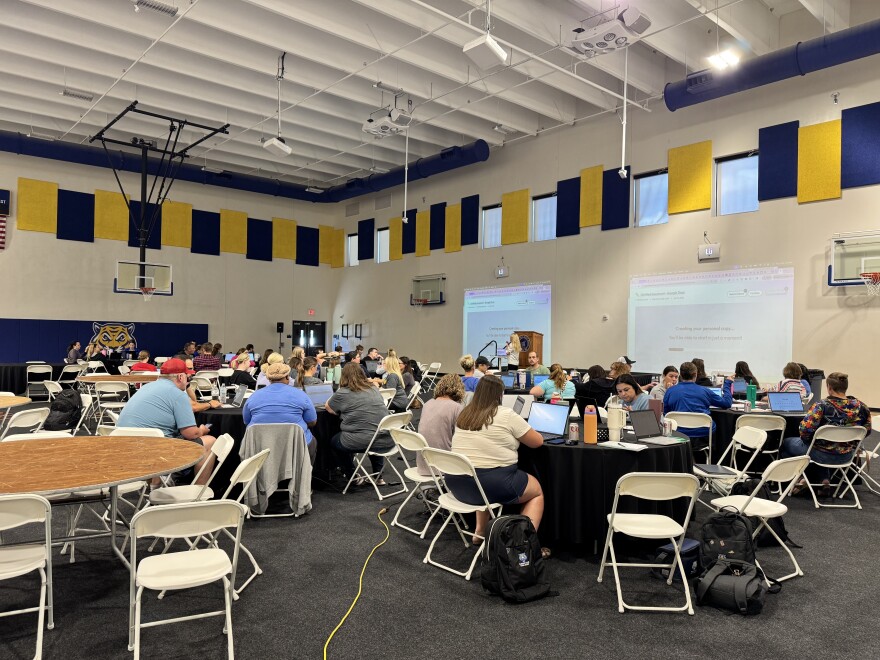Over 165 educators from across the area attended the St. Louis AI Summit, which was hosted by the Hancock Place School District in south St. Louis County.
The district adopted a policy around incorporating artificial intelligence tools into classrooms last summer.
It has spent roughly $25,000 on three contracts with different companies that create AI-powered tools for schools, according to Michelle Dirksen, director of technology for the district.
The district will be using three platforms called Snorkel, School AI and Brisk in the 2025-26 school year.
Dirksen said she’s seen tools evolve over her three-decade career in education technology, but AI is whole new territory.
“I think that's been what's been different about this, more than anything else, is that this is changing the world,” Dirksen said. “If we don't get on board and get our students ready for this, then they're going to be behind and we will have not done our job.”
Hancock Place Superintendent Kevin Carl said the decision to bring AI to the district comes with making sure students are prepared for a future with the technology.
“Integrating AI into the classroom is about empowering educators and students. AI has the potential to personalize learning, streamline routine tasks, and give teachers more time to focus on what matters most: building relationships and inspiring growth,” Carl said in a statement. “As educators, we have a responsibility to prepare students not just for the world as it is, but for the world as it will be. Embracing AI thoughtfully and ethically is part of that mission.”
The summit was attended by teachers and educators from districts including Parkway, Francis Howell and Kirkwood.
The discussion around incorporating AI into the classrooms remains controversial.
Some teachers across the country have said they are struggling with increased instances of cheating and plagiarism in classrooms, especially in high schools, colleges and universities.
Some critics also have pointed out that under-resourced school districts may not have the funds to pay for contracts with third-party education AI companies.
Dirksen emphasized that school districts need to start developing policies around how AI can be safely used in classrooms with the goal being to support students.
“We're not using it to give students answers. We're using it to help students become more creative and seek out answers and learn how to question and how to verify if information is correct,” Dirksen said.
For example, Dirksen said Snorkel allows teachers to see a student’s progress as they work on assignments.
The platform would provide a screen and audio recording of a student working on a device to answer a long division math problem. The teacher could review the recording to pinpoint where exactly the student is struggling and help address the problem.
Education leaders have begun to issue guidance on how schools should consider incorporating AI into classrooms.
The U.S. Department of Education released its guidance for school districts on Tuesday, encouraging them to adopt more AI tools into their curriculum in an effort to help students be career-ready.
The Missouri Department of Elementary and Secondary Education has also issued guidance for districts but has left the authority to local school boards to sign off on district policies.
Here’s an excerpt from the department's guidance:
“AI is rapidly surpassing expectations, indicating its inevitability in business, education, and the broader digital arena. Despite its benefits, AI tools may generate predictions that are not always accurate, potentially resulting in incomplete or misleading information. AI will generate confident predictions but can be flawed based on insufficient, biased, or flawed training data. As systems improve, these flaws may be reduced; however, human oversight will remain vital. This underscores the necessity for LEAs to address generative AI and its impact on both current education practices and prospective job market expectations for students.”
Mellomonique Greene, an English language arts teacher at Hancock Middle School, said she’s looking forward to teaching her students about AI.
“I'm not so much worried about cheating or copying and pasting because as the instructor in the room and setting it up, you have parameters that you could set,” Greene said. “You can set those boundaries and kind of let students play with the AI.”
Patrick McSalley, a sixth grade social studies teacher, said he’s looking forward to the tools making his job easier.
“Instead of a student turning in a writing sample to me that I then have to go read 60 of them, handwrite some notes and then give them back to me, which might take a day or two, now there’s an AI program that they can write something, I can give it the criteria, and it will instantly give them feedback,” McSalley said.






